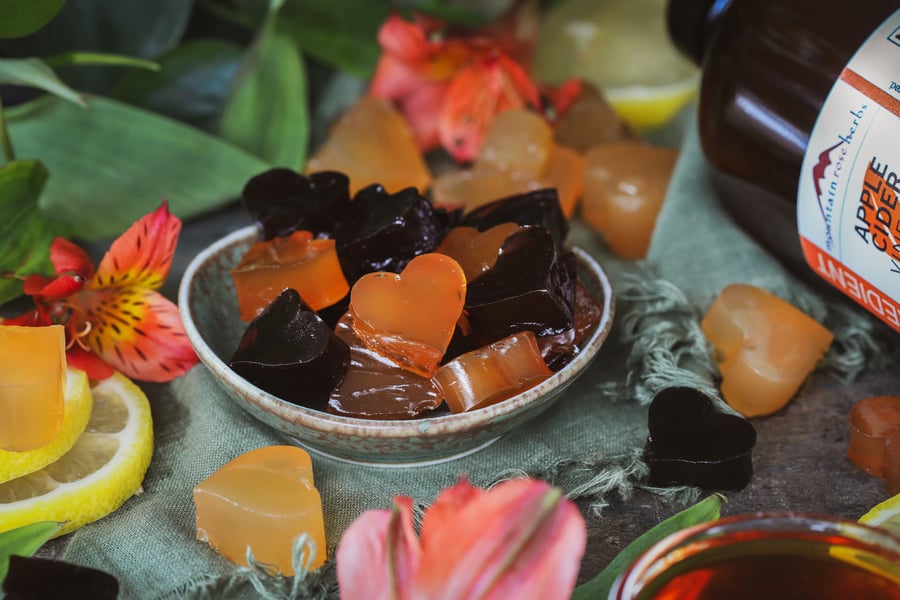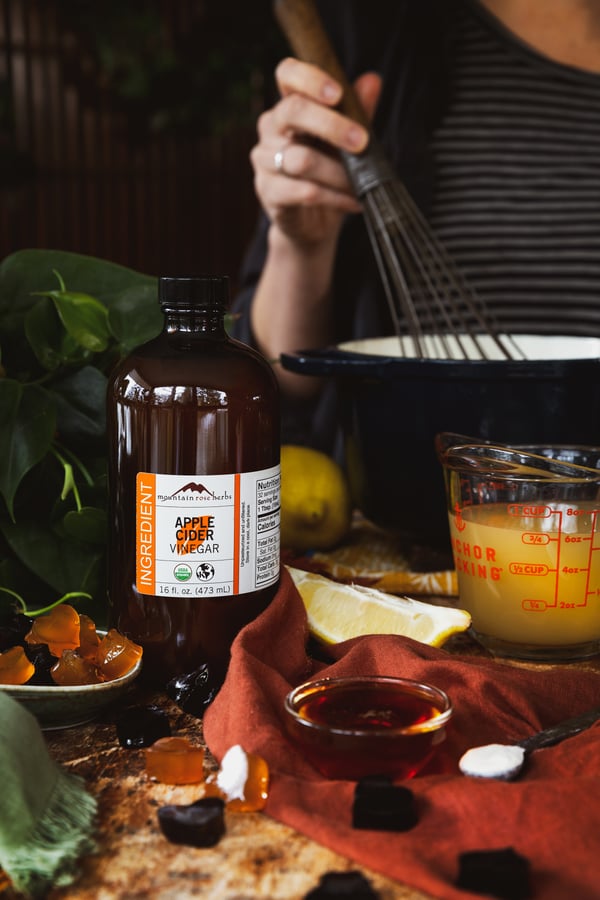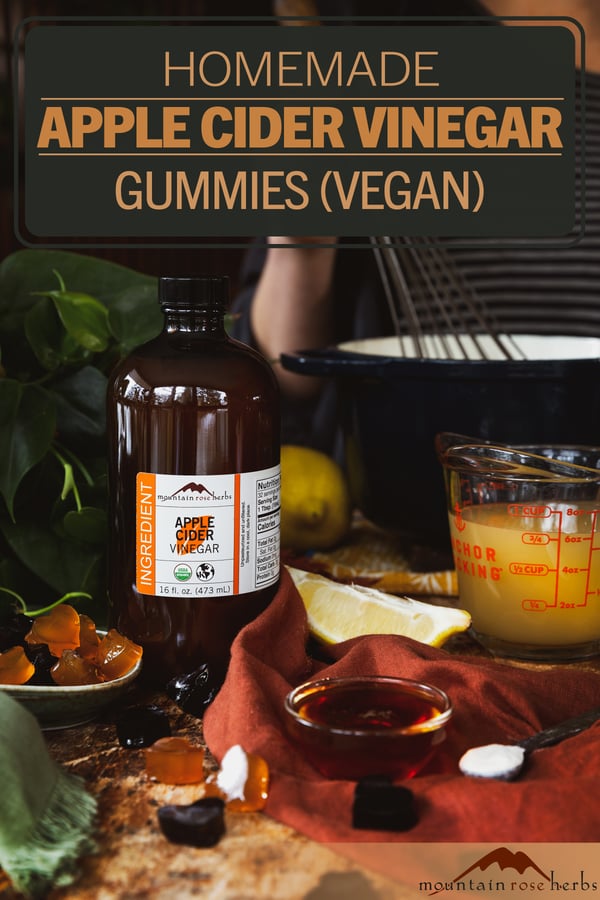I like inclusivity in food, and my friends and family group includes omnivores and vegetarians/vegans, as well as people with food allergies, autoimmune diseases, religious restrictions, etc. I love to feed my people, so I’m always experimenting, which is how I found myself going down this agar-agar as a replacement for gelatin rabbit hole, and then one thing led to another, and I got curious to know how much agar is the right amount for the best mouthfeel in vegan gummies (welcome to my brain). I made elderberry juice gummies, which were tasty and a fun way to get an extra boost of vitamins and minerals. Then I discovered apple cider vinegar gummies—I love these little ACV morsels!
These days, we see a lot of people turning to apple cider vinegar (ACV) for effective skin and hair treatments. ACV also has a long history of traditional use for digestive wellness dating back to ancient Greece. We now understand that ACV’s superpower with the digestive tract is that it is rich with gut-friendly bacteria that help support a healthy microbiome and discourage the unhealthy bacteria that have been linked to many serious health complications.
However, ACV has a strong flavor that many people find too intense. Similarly, fire cider is an excellent way to bring ACV into your daily diet, but it can be equally harsh on the palate. Herbal oxymels with infused herbs are a good alternative for some people, and sipping vinegars are delicious and easy on the palate. I think the easiest way to incorporate apple cider vinegar into your diet is to regularly include it in culinary recipes where its tart, bright flavor is perfect: marinades, sauces, soups, almost any cooked recipe involving fruit, etc. And, of course, there is the option of ACV gummies!
Why Use Agar-Agar Powder to Make Apple Cider Vinegar Gummies
Most over-the-counter gummies and DIY gummy recipes contain gelatin, which means they are off-limits for vegetarians/vegans and followers of some religious faiths. Replacing the gelatin with agar powder means my vegetarian son can enjoy them. That said, most vegan gummy recipes use so much agar-agar that you end up with a gummy that practically bounces and, frankly, the mouthfeel is unappetizing. The more agar you use, the firmer the gummies will be, and they will come out of a silicone mold more perfectly, so you get cute little gummy bears/drops/whatever. The payoff for all that perfection, however, is that biting that gummy is not necessarily a pleasant experience.
So, my goal is always to use as little agar powder as possible while still making a gummy that will work in a silicone mold and pop out without tearing. Even with minimal agar-agar, you should not expect a vegan gummy to have the same consistency as a gummy made with gelatin. A homemade apple cider vinegar gummy made with agar will have an appearance and mouthfeel much closer to a Japanese fruit jelly: beautifully colored, shiny, and delicious, but not chewy like a gelatin-based gummy. Adjusting your expectations beforehand will help you not be disappointed with the texture. Although I’m not vegan, when I can dial in the amount of agar powder perfectly, I prefer the mouthfeel of these ACV gummies over traditional gelatin ones.
A Quick Tip About Buying Apple Cider Vinegar
Many apple cider vinegars on the market are diluted. To get the ultimate benefits of ACV, you want to look for an undiluted one made with 100% organic apples. Mountain Rose Herbs’ ACV is pressed from the flesh of organic Washington State apples without cores or peels and shows the opacity and deep, rich color of undiluted vinegar.
Apple Cider Vinegar Gummies Recipe with Agar-Agar
Makes about 1 cup of gummy liquid.
Ingredients
- 1/2 cup organic pomegranate, apple, or other unsweetened fruit juice of choice
- 1/4 cup organic apple cider vinegar
- 1-3 Tbsp. organic sugar, honey, or maple syrup
- 1 1/2 - 2 Tbsp. organic lemon juice
- 1/2 tsp. pure 100% agar agar powder, or to taste
Directions
- Prepare the silicone molds you intend to use. Wash and wipe them dry. Set them on a plate or tray that will fit in your refrigerator and set aside on the counter.
- Whisk together fruit juice, apple cider vinegar, sweetener of choice, and lemon juice in a small, heavy-bottomed pot. Use more sweetener for sour juices like pomegranate and less for naturally sweet juices like apple—I like about 3 tablespoons with sour juices and 1 tablespoon for apple juice.
- Set the pot over medium heat and whisk in agar-agar slowly to thoroughly and smoothly incorporate. The more agar-agar you use, the firmer the gummies will be.
- Continue whisking as mixture comes to a boil, approximately 5 minutes.
- Boil 1-2 minutes while whisking to activate the agar-agar. The mixture will be thin, but you will see it starting to congeal on the sides of the pan.
- Set aside to cool for 4-5 minutes before putting into molds.
- Use a dropper or a spoon to fill molds.
- Put in the refrigerator and allow gummies to set up completely before you press them out.
- Store in an airtight container in the refrigerator for up to 3 days or freeze for 2-3 months.
Pro Tips
- We are making these gummies with pure agar-agar powder (as opposed to the flakes) with no additives. If you only have access to the flakes, you will need about three times as much as the powder, and it tends to clump more, so you may need to use an immersion blender to make a smooth gummy mixture. Similarly, if you can only find a product that is a blend of agar, the other additives can throw off your gummies, and you’ll need to calculate the actual amount of agar; for instance, if it’s 50% agar-agar, you’ll need twice as much.
- It can take a little “dialing in” to get the right amount of agar-agar to create a gummy with a mouthfeel you like that will also hold a shape. You can easily half or quarter the above recipe to make smaller experimental batches. Adjust the cooking times accordingly to achieve the same results.
- Using honey or maple syrup or freezing the gummies may change the texture and require a little more fiddling to get the correct proportions for you.
Want to Learn More About Agar-Agar?
Check Out Elderberry Gummies Made with Agar!
You May Also Enjoy
- How to Make Tulsi Sipping Vinegar + Spritzer and Shrub Cocktail Recipes
- Herbal Oxymel Recipes & Benefits
- Herbal Bath Vinegar with Juniper & Rosemary













